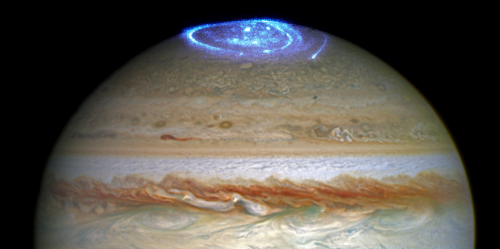By Hamish Johnston
Early next week NASA’s Juno spacecraft will fire its blasters and pop itself into orbit around Jupiter. On 24 June the approaching spacecraft fell under the spell of the planet’s powerful magnetic field and the transition was captured by Juno’s Waves instrument, which measures radio and plasma waves.
The signals have been converted to sound and you can listen to them in the above video. There are two abrupt changes in the signal from Waves. One is a shift from a high-pitch whisper to a low-frequency roar that occurs when Juno crosses Jupiter’s bow shock. This is where the supersonic solar wind is slowed by the planet’s magnetic field and the roar is the equivalent of a sonic boom here on Earth.
About a day later Juno crossed the magnetopause, which is the boundary between the magnetic fields of the Sun and Jupiter. At this point the sound shifted from a low-pitched roar to a high-frequency whistle that is modulated in amplitude by radiation that is trapped within the magnetic field.
Jupiter’s huge magnetic field is also responsible for the equally huge Jovian aurora, which you can see in the image below taken by the Hubble Space Telescope.

Jovian aurora. (Courtesy: NASA, ESA and J Nichols/University of Leicester)
Next up in the Red Folder is the claim that UK scientists and a Norway-based company called Helium One have discovered a huge underground reserve of helium in Tanzania. As well as floating balloons and making your voice squeaky, helium has a number of practical uses – not least being the cooling of superconducting magnets in magnetic resonance imaging (MRI) medical scanners.
The noble gas is produced by radioactive decay deep within the Earth and tends to accumulate in the same places as underground reserves of oil and gas. The US had a huge strategic supply of helium, but that has been sold off at a rapid rate and scientists are worried that there may soon not be enough helium to run MRI machines and cool the Large Hadron Collider. You can read about the discovery in “Scientists unearth one of world’s largest helium gas deposits”.
While helium is difficult to find, it’s not nearly as elusive as dark matter. To help sort fact from fiction, the folks at the Perimeter Institute for Theoretical Physics have created a series of slides called “What we know (and don’t know) about dark matter”. I didn’t realize, for example, that the concept of dark matter was first introduced in 1922 by Dutch astronomer Jacobus Kapteyn, who was studying the velocities of stars. I had thought it was first mooted a decade later in 1933, by the Swiss astrophysicist Fritz Zwicky.
I guess a problem with the PBH’s is that if there are enough to account for dark matter then shouldn’t there be a lot more evidence for black hole evaporation too? – unless that theory is wrong. Also it would suggest (to me) a slower start to the emergence of the cosmos.. at odds with Inflation theory.. and a whole new understanding of big bang cosmology perhaps.